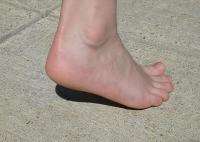Short heels make elite sprinters super speedy

What is it about elite sprinters that gives them the edge over non-sprinters in the 100m dash? Stephen Piazza from the Pennsylvania State University publishes his discovery, in The Journal of Experimental Biology, that the length of an elite sprinter's heel (the distance from the back of the heel to the ankle) is 25 percent shorter in elite athletes than non-sprinters, allowing them to generate more force when sprinting for gold.
When 100 m sprinters launches themselves from the starting blocks, the race can be won or lost in the first few strides. Acceleration through the first few strides is the key to winning gold. So when Stephen Piazza was approached by an American football star, who sprints in his position of wide receiver, to find out how he could improve his technique and training regime, Piazza decided to focus on the athlete's ankles to try to discover what gives elite sprinters the edge over ordinary mortals and publishes his findings on 30 October 2009 in The Journal of Experimental Biology.
The effectiveness of an accelerating sprinter's push off depends on the amount of leverage that the calf muscles have when pulling on the back of the heel to pull it up as it pushes the toes down, and off, the ground. Piazza figured that the athlete's foot would have a large distance from the ankle to the back of the heel to produce a long 'heel lever' for the calf muscle to pull on when pushing the toes down. In this case, the calf muscle would have to contract and pull the heel up over a long distance, so Piazza measured how far the athlete's tendon moved (translated) while pulling the athlete's heel up to see how it compared with that of non-sprinters. Piazza says 'I thought it would be one of the largest (tendon translations]) we had ever measured'. But when he and his student, Sabrina Lee, measured the distance, they were surprised to find that it was much shorter than average. Was the football star the exception or the rule?
Piazza decided to compare the Achilles' tendon translation of elite athletes with that of non-sprinters. Working with sprinters and long jumpers from Lock Haven University, and local non-sprinters, Piazza and Lee used ultrasound imaging to measure the tendon's translation as the subjects pointed their toes. Amazingly, the distance was 25% shorter in the elite athletes than in the non-sprinters. Instead of benefiting from the mechanical advantage of having a long heel lever, the sprinters seemed to be at a mechanical disadvantage because their heel levers were much shorter.
Puzzled by this unexpected discovery, Piazza turned to the literature to find out how animal sprinters' ankles are constructed, and quickly realised that the human elite athletes were built inline with their animal counterparts, which also have short heel levers. So how does this mechanically disadvantageous arrangement give elite sprinters the edge over weekend joggers?
Piazza and Lee realised that a fundamental property of all muscles could be responsible for the sprinters' unexpectedly short Achilles' tendon translations. He explains that muscles that contract quickly cannot generate much force, giving runners with a long moment arm a weak push off despite their increased mechanical advantage. However, muscles that contract slowly produce much greater forces that overcome the mechanical disadvantage of a short heel lever, giving sprinters with a short heel lever a powerful push off.
Testing his theory with a mathematical model of a sprinter's body, it was clear that the extra force generated by the calf muscle as it pulled the short heel lever would provide sprinters with the additional acceleration required to get ahead in the first few strides. And when the duo compared other physical characteristics between the sprinters and non-athletes, they noticed that the sprinters' toes were almost 1 cm longer than those of the non-sprinters. Not only could the sprinter generate more force while accelerating, but their longer toes allowed them to remain in contact with the ground longer during each stride, giving them longer to push against the surface and out perform slower sprinters.
More information: Lee, S. S. M. and Piazza, S. J. (2009). Built for speed: musculoskeletal structure and sprinting ability. J. Exp. Biol. 212, 3700-3707. http://jeb.biologists.org
Source: The Company of Biologists (news : web)
















